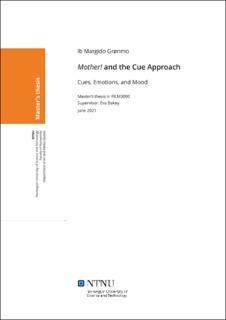| dc.contributor.advisor | Bakøy, Eva | |
| dc.contributor.author | Grønmo, Ib Margido | |
| dc.date.accessioned | 2021-09-14T16:16:50Z | |
| dc.date.available | 2021-09-14T16:16:50Z | |
| dc.date.issued | 2021 | |
| dc.identifier | no.ntnu:inspera:76652469:37738493 | |
| dc.identifier.uri | https://hdl.handle.net/11250/2776711 | |
| dc.description.abstract | I denne tesen, så er hovedmålet mitt å utforske viktige aspekter av hva som gjør Mother! (Aronofsky, 2017) til en emosjonelt engasjerende film. For å kunne gjøre dette på en nyansert og effektiv måte, så har jeg bestemt meg for å integrere tre teoretiske perspektiv som handler om emosjonelt engasjement (narrativt engasjement teori, karakter engasjement teori, og stemnings-teori) inn i et analytisk rammeverk som er i stand til å analysere ulike aspekter av en films emosjonelle appell. Jeg kaller dette analytiske rammeverket for «the cue approach», og ved å kombinere innsikt fra flere kognitive film-teoretikere, så er «the cue approach» designet for å kunne undersøke en variasjon med «cues» (signaler) som kan lokke frem en variasjon av emosjonelle responser, inkludert historie-rettede emosjoner (nysgjerrighet og suspens), karakter-rettede emosjoner (sympati, empati, og følelser av nærhet), og stemning. Alt i alt, så vil jeg argumentere for at Mother! er strukturert for å lokke frem en høy grad av nysgjerrighet, suspens, følelser av nærhet, kroppslig empati, sympati, og en uhyggelig og engstelig stemning, og jeg vil argumentere for at disse elementene er viktige aspekter av hva som gjør Mother! til en emosjonelt engasjerende film. | |
| dc.description.abstract | In this thesis, my primary aim is to examine important aspects of what makes Mother! (Aronofsky, 2017) an emotionally engaging film, but in order to do this in a nuanced and effective way, I have decided to integrate three theoretical perspectives about emotional engagement (narrative engagement theory, character engagement theory, and mood theory) into an analytical framework that is capable of analyzing different aspects of a film’s emotional appeal. I call this analytical framework the cue approach, and by combining different insights from several cognitive film theorists, the cue approach is designed to be able to examine a variety of cues (signals) that can elicit a variety of emotional responses, including story-directed emotions (curiosity and suspense), character-directed emotions (sympathy, empathy, and feelings of closeness), and mood. Overall, I will argue that Mother! is structured to elicit a high degree of curiosity, suspense, feelings of closeness, embodied empathy, sympathy, and an eerie and anxious focalized mood, and I will argue that these elements are important aspects of what makes Mother! an emotionally engaging film. | |
| dc.language | eng | |
| dc.publisher | NTNU | |
| dc.title | Mother! and the Cue Approach: Cues, Emotions, and Mood | |
| dc.type | Master thesis | |
